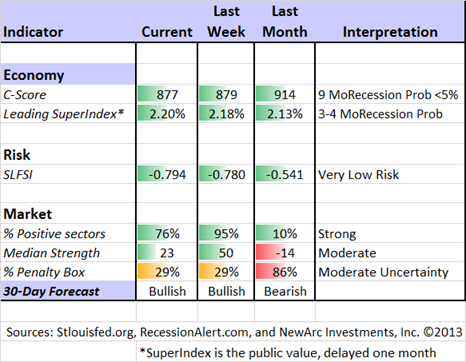Last week I asked whether it was time for the regular year-end rally. This was a pretty good guess about the media focus for last week. With little fresh data on the calendar, it is open season for pundits. Here are the themes I see:
- Technical traders who see a short-term top;
- The regular parade of crash predictors; and
- Those who turn every investment question into a complaint about the Fed.
There is a surprising new theme – the chance that markets might move much higher, and in a short time. Some are using the term "melt-up."
- Schwab's Liz Ann Sonders, not one given to hyperbole, asks, Why Worry … About a Melt-Up? She takes note of short-term sentiment risk.
- Ed Yardeni, who has been accurately bullish, but certainly not a perma-bull, has a nice interview in the current Barron's. Like Sonders, he notes near-term risks, but sticks with a target of S&P 2014 in 2014. It could happen fast.
I have some thoughts about upside risk, which I'll report on those in the conclusion. First, let us do our regular update of last week's news and data.
Background on "Weighing the Week Ahead"
There are many good lists of upcoming events. One source I regularly follow is the weekly calendar from Investing.com. For best results you need to select the date range from the calendar displayed on the site. You will be rewarded with a comprehensive list of data and events from all over the world. It takes a little practice, but it is worth it.
In contrast, I highlight a smaller group of events, including some you have not seen elsewhere. My theme is an expert guess about what we will be watching on TV and reading in the mainstream media. It is a focus on what I think is important for my trading and client portfolios. Each week I consider the upcoming calendar and the current market, predicting the main theme we should expect. This step is an important part of my trading preparation and planning. It takes more hours than you can imagine.
My record is pretty good. If you review the list of titles it looks like a history of market concerns. Wrong! The thing to note is that I highlighted each topic the week before it grabbed the attention. I find it useful to reflect on the key theme for the week ahead, and I hope you will as well.
This is unlike my other articles at "A Dash" where I develop a focused, logical argument with supporting data on a single theme. Here I am simply sharing my conclusions. Sometimes these are topics that I have already written about, and others are on my agenda. I am putting the news in context.
Readers often disagree with my conclusions. Do not be bashful. Join in and comment about what we should expect in the days ahead. This weekly piece emphasizes my opinions about what is really important and how to put the news in context. I have had great success with my approach, but feel free to disagree. That is what makes a market!
Last Week's Data
Each week I break down events into good and bad. Often there is "ugly" and on rare occasion something really good. My working definition of "good" has two components:
- The news is market-friendly. Our personal policy preferences are not relevant for this test. And especially -- no politics.
- It is better than expectations.
The Good
This was a week of surprising economic strength. It was encouraging that both stocks and bonds interpreted this as good news.
- Payroll employment showed surprising strength. The October job gains, combined with revisions to the prior two months, suggest a new level of economic growth, consistent over several months. (See Household Employment below).
- Any Fed "taper" of QE is likely to be offset by lower short-term rates. Joe Weisenthal explains the significance, citing the economist who has been most accurate over the last several years, Jan Hatzius.
- Rail traffic is strong. (Via Pragmatic Capitalism).
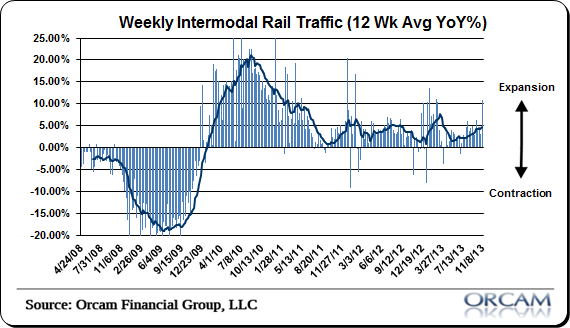
- The ISM service index showed strength at 55.4. Steven Hansen notes the expansionary trend and analyzes the internals. He remains skeptical of anything involving a survey question. I think that purchasing managers can be pretty accurate in reporting what they are seeing in their businesses. We have decades of knowledge about how to do surveys. They are not all the same.
- Gas prices hit another low.
- Q3 GDP showed surprising strength. There are so many moving parts that even a strong number can be criticized. Inventories increased. Does this mean anticipated demand or lack of sales? Business investment still lags. There will be revisions. And so forth. Even with some allowances, this report seems more consistent with stronger growth. Doug Short's chart shows the components of growth over time, helping us see the drag from government and trade.
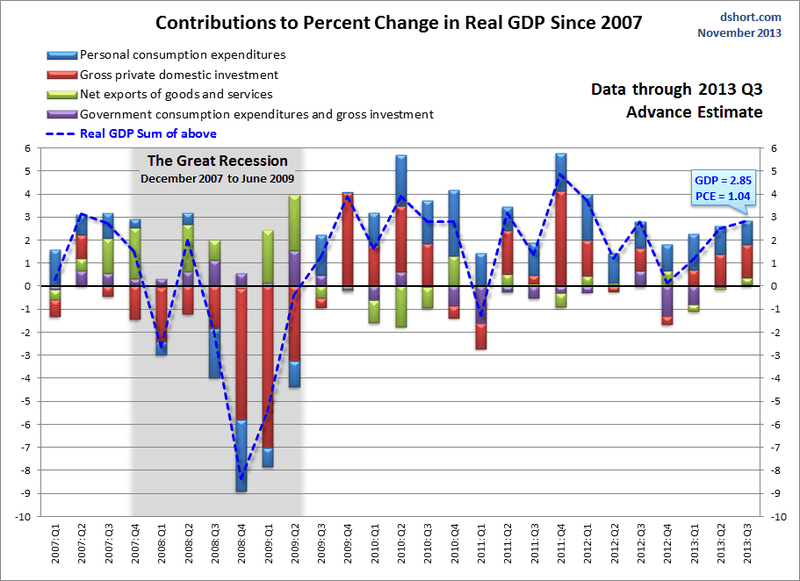
The Bad
The news updates also included some bad news. I did not see too much, but feel free to add suggestions in the comments. These should be items from the current week, not the repetition of something you could have said (and probably did) six months ago!
- Investor sentiment has gotten bullish. From a contrarian perspective, this is a short-term bearish indicator. (Via theshortsideoflong).
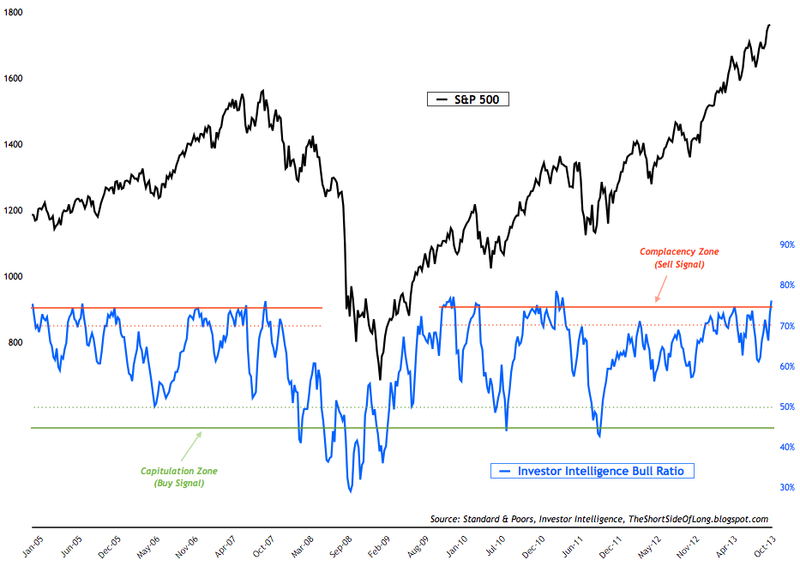
- Mortgage credit remains tight. This is hurting the economy (via Calculated Risk).
- Michigan sentiment was terrible, once again. Calculated Risk attributes the decline to Washington and expects the upward trend to resume. Meanwhile, this is worrisome for those of us who see it as an indicator of both consumption and employment. Here is a helpful chart:
- Household employment survey shows weakness – a drop in labor participation, full-time jobs, and part-time jobs. I am taking note of this, but this survey was more affected by the government shutdown than the payroll approach. The bond market seemed to agree, with rates spiking higher on the news. Another month of data will provide some needed clarity.
The Ugly
The Philippines typhoon – with a death toll of 10,000 – should provide perspective for the routine news of the week.
Silver Bullet
I occasionally give the Silver Bullet award to someone who takes up an unpopular or thankless cause, doing the real work to demonstrate the facts. Think of The Lone Ranger. No award this week, but nominations are always open.
The Indicator Snapshot
It is important to keep the current news in perspective. I am always searching for the best indicators for our weekly snapshot. I make changes when the evidence warrants. At the moment, my weekly snapshot includes these important summary indicators:
- For financial risk, the St. Louis Financial Stress Index.
- An updated analysis of recession probability from key sources.
- For market trends, the key measures from our "Felix" ETF model.
Financial Risk
The SLFSI reports with a one-week lag. This means that the reported values do not include last week's market action. The SLFSI has recently edged a bit higher, reflecting increased market volatility. It remains at historically low levels, well out of the trigger range of my pre-determined risk alarm. This is an excellent tool for managing risk objectively, and it has suggested the need for more caution. Before implementing this indicator our team did extensive research, discovering a "warning range" that deserves respect. We identified a reading of 1.1 or higher as a place to consider reducing positions.
The SLFSI is not a market-timing tool, since it does not attempt to predict how people will interpret events. It uses data, mostly from credit markets, to reach an objective risk assessment. The biggest profits come from going all-in when risk is high on this indicator, but so do the biggest losses.
Recession Odds
I feature the C-Score, a weekly interpretation of the best recession indicator I found, Bob Dieli's "aggregate spread." I have now added a series of videos, where Dr. Dieli explains the rationale for his indicator and how it applied in each recession since the 50's. I have organized this so that you can pick a particular recession and see the discussion for that case. Those who are skeptics about the method should start by reviewing the video for that recession. Anyone who spends some time with this will learn a great deal about the history of recessions from a veteran observer.
I also feature RecessionAlert, which combines a variety of different methods, including the ECRI, in developing a Super Index. They offer a free sample report. Anyone following them over the last year would have had useful and profitable guidance on the economy. RecessionAlert has developed a comprehensive package of economic forecasting and market indicators. Their most recent report provides a market-timing update for those considering whether to "buy the dips."
Georg Vrba's four-input recession indicator is also benign. "Based on the historic patterns of the unemployment rate indicators prior to recessions one can reasonably conclude that the U.S. economy is not likely to go into recession anytime soon." Georg has other excellent indicators for stocks, bonds, and precious metals at iMarketSignals.
Unfortunately, and despite the inaccuracy of their forecast, the mainstream media features the ECRI. Doug Short has excellent continuing coverage of the ECRI recession prediction, now two years old. Doug updates all of the official indicators used by the NBER and also has a helpful list of articles about recession forecasting. Doug also continues to refresh the best chart update of the major indicators used by the NBER in recession dating. The ECRI approach has been so misleading and so costly for investors, that I will soon drop it from the update. The other methods we follow have proved to be far superior.
Readers should review my Recession Resource Page, which explains many of the concepts people get wrong. There is now an updated analysis showing the impact of the government shutdown – moving some measures into "recession warning" territory.
Here is our overall summary of the important indicators.
Our "Felix" model is the basis for our "official" vote in the weekly Ticker Sense Blogger Sentiment Poll. We have a long public record for these positions. Over the last two months Felix has ranged over the full spectrum – twice! The market has been moving back and forth around important technical levels, driven mostly by news.
Felix does not react to news events, and certainly does not anticipate effects from the headlines. This is usually a sound idea, helping the trading program to stay on the right side of major market moves. Abrupt changes in market direction will send sectors to the penalty box. The Ticker Sense poll asks for a one-month forecast. Felix has a three-week horizon, which is pretty close. We run the model daily, and adjust our outlook as needed.
The penalty box percentage has decreased dramatically, meaning that we have more confidence in the overall ratings.
[For more on the penalty box see this article. For more on the system ratings, you can write to etf at newarc dot com for our free report package or to be added to the (free) weekly ETF email list. You can also write personally to me with questions or comments, and I'll do my best to answer.]
The Week Ahead
We have finally caught up with the delayed data, and this week brings an unusually thin calendar of events.
The "A List" includes the following:
- Initial jobless claims (Th). Resuming a key role as the most responsive employment measure.
- Industrial production (F). A key recession indicator.
- Yellen confirmation hearings (Th). Senate Banking Committee. The confirmation is unlikely to be derailed, but there could be interesting news along the way.
The "B List" includes:
- Trade balance (Th). Another GDP component.
There will also be plenty of FedSpeak. Options expiration week could exacerbate what would ordinarily be smaller moves.
I am not very interested in lesser reports like Empire state and wholesale inventories.
How to Use the Weekly Data Updates
In the WTWA series I try to share what I am thinking as I prepare for the coming week. I write each post as if I were speaking directly to one of my clients. Each client is different, so I have five different programs ranging from very conservative bond ladders to very aggressive trading programs. It is not a "one size fits all" approach.
To get the maximum benefit from my updates you need to have a self-assessment of your objectives. Are you most interested in preserving wealth? Or like most of us, do you still need to create wealth? How much risk is right for your temperament and circumstances?
My weekly insights often suggest a different course of action depending upon your objectives and time frames. They also accurately describe what I am doing in the programs I manage.
Insight for Traders
Felix continues in bullish mode. In our trading accounts we have been fully invested and the positions have gradually become more aggressive. Felix's ratings have been in a fairly narrow range for several months. The rapid news-driven shifts are not the ideal conditions for Felix's three-week horizon. This week we see somewhat lower ratings and fewer sectors in the penalty box. It is one of the most encouraging combinations in months.
Insight for Investors
I review the themes here each week and refresh when needed. For investors, as we would expect, the key ideas may stay on the list longer than the updates for traders.
- Headlines. The challenge for investors is to distinguish between the major trends and the short-term uncertainty. The main themes are not related to headlines news, even though sentiment may drive market fluctuations. Do not be seduced by the idea that you can time the market, calling every 10% correction. Many claim this ability, but few have a documented record to prove it. Most who claim past success are using a back-tested model. Please see The Seduction of Market Timing.
- Risk Management. It is far better to manage your risk, specifically considering the role of bonds and the risk of bond mutual funds. As I emphasized, "You need to choose the right level of risk!" Right now, it is the most important question for investors. There is plenty of "headline risk" that may not really translate into lower stock prices. Instead of reacting to news, the long-term investor should emphasize broad themes.
- Avoiding the "fear trade." I covered this pretty carefully a couple of weeks ago. Those who participated in our "methadone program" for gold addiction enjoyed some nice gains in our substitute, Freeport-McMoRan Copper and Gold (FCX). This made 35% in a few months, counting both dividends and stock appreciation, but we have now moved on because of valuation. Gold continues to lose ground, but the rationale is even more disturbing. The gold traders are intensely focused on the Fed. Since I do not expect any big changes in Fed policy, nor any major effects from the first moves, this is simply a wrong-headed trade. Individual investors have been chased into gold because of fear of economic collapse (via deflation), or hyperinflation, or sometimes both at the same time. Since none of these outcomes is very likely, you should have only a small allocation to precious metals.
- Stepping in gradually. If you are completely out of the market, you are not alone. Consider buying dividend stocks and selling calls against them. This strategy has been working great both for our clients and for many readers. (Thanks for the email responses!) This will work in a sideways market. You can also buy some stock in the sectors with the best P/E ratios.
And finally, we have collected some of our recent recommendations in a new investor resource page -- a starting point for the long-term investor. (Comments and suggestions welcome. I am trying to be helpful and I love feedback).
Final Thought
Risk is not just a matter of the downside. Early in 2010 I wrote an important short post: Upside Risk. I quoted a leading manager explaining the factors that could lead to much stronger stocks.
Earlier this year, when everyone was obsessed with the "T" word, I asked whether investors should be "scared witless" (A TM OldProf Euphemism).
This was a post from June. Much of the story is playing out as predicted, and we are entering the strong seasonal part of the year.
As the investment world returns to a more normal state, we can expect the following:
- A return to trend GDP – 3%+ or even better
- Stronger employment growth
- Higher interest rates – think of 4% on the ten-year note
- Higher market multiples – because the relationship between stock multiples and bond rates is curvilinear. None of the top Wall Street economists has gotten around to replicating my research, but they will. Unlike them, I'll be happy to share the data for verification.
- Lower unemployment
- Reduced profit margins
- Stronger total profits and revenues
- Reduced budget deficits, especially as a percentage of GDP
These are all correlated. Bulls cannot cherry-pick the good stuff and ignore the others. Neither can bears. No fair asking what stock prices would be if profit margins and interest rates "normalized" without allowing for other variables to change as well. See here for details.
Investment Conclusion
Stock prices and interest rates are on a path to the Final Destination. This should be your guide to choosing investments.
The worst investments are those linked to interest rates – bonds, utility stocks, and the grandma dividend stocks.
The best investments are those with low current PE ratios and sensitive to the economy. Bernanke told us that he expects stronger economic growth and the pedal will be mostly to the metal even so. This is bullish for technology, cyclical stocks, discretionary consumer stocks, and financials.
I am comfortable with these conclusions, but there is one update. JP Morgan's excellent quarterly analysis supports my point about rising interest rates and P/E multiples. Rising rates have historically been positive for stocks, as long as the ten—year is below 4.5%. This is a valuable and little-known fact. 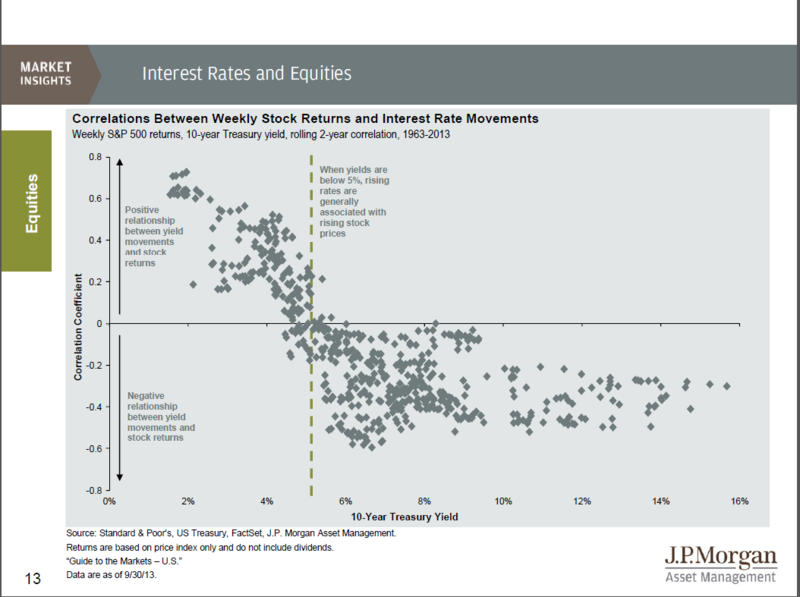
Investment Implication
There is no need to go "all-in" like the players in the World Series of Poker! You can right-size your risk (via individual bonds or covered calls on dividend stocks) and still benefit from the continuing improvement in the economy and in US equities.


